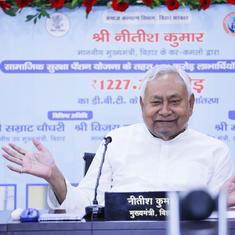An unorthodox left-arm spinner is among the rarest class of bowlers in cricket with possibly the most unique bowling action.
This special type of bowler imparts unorthodox spin on the ball, turning the ball into a right-arm batter (much like a off-spinner) rather than conventional left-arm spin which turns the ball away from a right-hand batter.
But as enthralling as they are to watch, they are just as difficult to pick and play, as Australia learned the hard way in both the Test match at Dharamsala earlier this year as well as the second One-Day International at Kolkata on Thursday. With five Australian wickets remaining, the visitors would have seen themselves in with some chance of chasing 252. But then came Kuldeep Yadav and took a hat-trick to ensure India maintained their lead.
#AUSvIND Kuldeep Yadav took Hat-Trick. #Australia pic.twitter.com/t46i0ore80
— Bharat Sharma (@DekhoIsko) September 21, 2017
The 22-year-old sent back Matthew Wade, Ashton Agar and Pat Cummins in as many balls. Yadav first got through Wade’s stumps, then trapping Agar in front and for the coup de grace, he bowled the wrong one that took a thick edge of Cummins’ bat before landing into the hands of MS Dhoni.
In Dharamsala, the then debutant Yadav had taken 4/68 in the first innings to pull back the match for on the first to make sure India won the hard-fought Test series. With his tricky action and array of variations, Yadav, India’s first unorthodox left-arm spinner at the international level, can befuddle the best of batters.
The ‘Chinaman’ origins
Colloquially called “Chinaman”, the term’s origin has racist connotations and therefore is not preferred to describe this particular style of bowlers. According to the Sydney Morning Herald column, the term became popular after a 1933 Test between England and West Indies at Old Trafford, when Ellis “Puss” Achong, a left-arm finger-spinner and the first Test cricketer of Chinese ancestry, dismissed English batsman Walter Robins with wrist-spin. Robins supposedly said “Fancy being done by a bloody Chinaman” while walking back to the pavilion and the term has stuck since then.

There was vocal support on social media for the term to be done away with when Yadav came into global attention during the Test series. However, before that, it was widely used to describe these rare bowlers. The most prominent among the lot are Chuck Fleetwood-Smith, Brad Hogg, Lakshan Sandakan and sometimes players like Garry Sobers, Michael Bevan and the “frog-blender” Paul Adams as well.
Chuck Fleetwood-Smith
Happy 109th birthday to one of cricket's most flamboyant bowlers of left-arm wrist spin Chuck #Fleetwood Smith pic.twitter.com/6t8Nd8bI0h
— Rick Eyre on cricket (@rickeyrecricket) March 29, 2017
Australia’s Chuck Fleetwood-Smith was the first left-arm wrist spinner to don the Baggy Green and among the first left-arm unorthodox spinners to use the skill to prodigious effect. However, his domestic and international returns didn’t quite add up. He played 10 Tests between 1935 and 1938, taking 42 wickets. But in First-Class cricket, he had 597 wickets from 112 games.
According to his profile on ESPNCricinfo, he was a left-arm spin bowler who changed his style after breaking his right arm as a schoolboy. In school, he was supposedly ambidextrous and could bowl with either arm.
An interesting thing about Fleetwood-Smith is that despite his erratic international performances, he was regarded as one of the best turners of the ball by Don Bradman. “At his top he would deceive anybody as to which way the ball would turn, and his great spin and nip off the pitch were most disconcerting. This necessarily brought inaccuracy in its train, and many a time he became the despair of his captain because of his loss of control,” Bradman was quoted to have said by a profile on the spinner by Cricket Country.
Brad Hogg
Brad Hogg is perhaps the most popular left-arm orthodox bowlers with a career spanning almost two decades with over 100 wickets in ODIs and T20I cricket. Even his autobiography is called The Wrong’Un.
His unorthodox style first took centre stage during the 2003 World Cup. Filling in for the suspended Shane Warne, he is credited for one of the best deliveries of the tournament. He bowled a stunning flipper to Zimbabwe’s Andy Flower, one of cricket’s better players of spin, which went straight through the gate and knocked the bamboozled batsman’s stumps off. This was described by Adam Gilchrist as “one of the balls of the tournament” in his book Walking to Victory.
Hogg, a member of Australia’s victorious 2003 and 2007 World Cup teams, is however best remembered for his incredible return to Twenty20 cricket. In 2011, he made surprise comeback to the T20 format and played for Perth Scorchers in the Big Bash League. His success in the shortest format earned him a call-up to the 2012 and the 2014 World Twenty20. Contracts for franchise-based Twenty20 leagues then started pouring in, even as his unusual action brought in the wickets. In fact, Hogg is the player over 40 years of age to take 100 wickets in the shortest format. Talk about impact!
Lakshan Sandakan

Sri Lanka have a history of turning out unconventional spinners and 26-year-old Lakshan Sandakan is just one in a list headlined by the likes of Muttiah Muralitharan and Ajantha Mendis.
The left-arm wrist-spinner who hails from the outskirts of Colombo was prolific in domestic cricket which earned him a call-up to the national team. But he set down a marker of his quality when he made his debut in July 2016: in Pallekele against Australia in July 2016.
After bowling Sri Lana out for 117, Australia had no idea what hit them, assailed by the left-arm conventional spin of Rangana Herath and the unconventional wizardry of Sandakan. The debutant took 4/58 in the first innings and then continued to leave the Aussies bamboozled in the second innings as well with figures of 3/49.
His combined match figures of 7/107 were the best by a left-arm wrist spinner on debut in Tests. More recently, Sandakan put in a Man of the Match performance in an ODI against Zimbabwe where he took four wickets and also took a five-wicket haul against India in the third Test of their recent series.
Do you prefer your favourite sports stories delivered straight to your inbox every weekday? We have got you covered. Subscribe to The Field’s newsletter.










